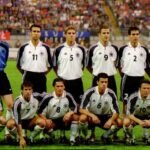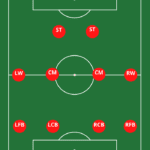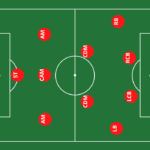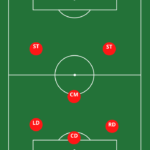- Last Updated -
Kickoff: A Brief Overview of German Soccer in the 2000s
The Dawn of a New Era – Transformation of German Soccer
As we entered the new millennium, German soccer found itself standing at a precipitous crossroads. The decade that preceded it had been marked by a mixture of noteworthy triumphs and bitter disappointments.
The national team was still basking in the glory of its 1996 UEFA Euro win, but the reality was that this success camouflaged underlying issues.
There were lingering concerns about an ageing squad, outdated tactics, and lackluster performances in major tournaments. Meanwhile, German domestic soccer clubs were not faring much better at the beginning of the 2000s.
Bundesliga—the premier professional association football league in Germany—had seen better days. Its clubs struggled to make significant impacts on European stages where English and Spanish teams had taken center stage.
However, every dusk promises a dawn. And for German soccer, this dawn arrived with an invigorating wave of transformation that altered its landscape forever.
A Game Changer in Disguise
The seed for change was planted ironically in arguably one of their worst moments—Germany’s disappointing performance at the UEFA Euro 2004 tournament where they failed to progress beyond the group stage.
This was widely perceived as a wakeup call—a blaring siren indicating that change was not just needed; it was imperative. This pivotal moment led to meaningful introspection within Germany’s football governing body (DFB).
The outcome? A series of far-reaching reforms that would eventually result in reviving both their national team and club football standards over subsequent years.
In retrospect, defeat became Germany’s ally; loss their catalyst for transformation. The ensuing revolution proved essential for propelling German soccer into an entirely new realm—one filled with promise and potential.
The Birthplace of Modern Titans
The metamorphosis within German soccer wasn’t restricted to mere tactical or strategic changes; it also catalyzed a striking evolution within player development programs across all levels.
Emerging talents shone brighter than ever as academies started churning out players who would go on to become modern titans known worldwide—players like Bastian Schweinsteiger, Thomas Müller, Mesut Özil—to name a few.
This concerted effort towards youth development not only bolstered Germany’s homegrown talent pool but played an instrumental role in raising Bundesliga’s overall standard too.
Indeed clubs such as Borussia Dortmund and Bayern Munich started making regular appearances at later stages of prestigious European competitions—a testament to their growth and increased capabilities.
In essence, what transpired within German soccer during this transformative decade charted out an exemplary blueprint—not just for reviving sporting prowess but also overcoming persistent challenges with grace under pressure—and is still considered one of sport’s most inspiring success stories today.

The Early 2000s: “Off to a Rocky Start”
As we embarked on the new millennium, German soccer found itself in a precarious position. The once indomitable force seemed more like a jester than a juggernaut, stumbling through tournaments with an uncharacteristic lack of coordination and finesse.
The early 2000s were marred by disappointing performances and heartbreak on both the national team and club-level fronts.
The Struggles of the National Team: “Not Quite World Cup Material”
In stark contrast to the team’s glory days, Deutschland was struggling to find its footing on the international stage in this era. The turn of the century did little to illuminate their fortunes; instead, it brought forth a period shrouded in mediocrity.
The most poignant example perhaps was FIFA World Cup 2002 where despite making it all the way to final, their performance left much to be desired for fans accustomed to seeing Die Mannschaft dominate play with seamless precision.
Uninspired play marked by lack of creativity and dynamism plagued them throughout the tournament; they were often reliant more on individual brilliance or opponents’ mistakes than cohesive team effort. Then came UEFA Euro 2004 which further highlighted their inadequacies.
Failing even to make it past group stages was an unprecedented low for a side that had once struck fear into every opponent’s heart. The German outfit lacked firepower upfront while displaying vulnerability at back – far from being world cup material they once used to be.
Club-Level Challenges: “Bundesliga Blues”
While Germany’s national team struggled, so too did many Bundesliga clubs during this period. While traditionally powerful sides like Bayern Munich continued their dominance domestically, they found replicating such success in Europe a tall order.
Despite boasting squads filled with prodigious talents, Bundesliga outfits consistently fell short against Europe’s elite clubs in Champions League encounters – unable able match them either technically or tactically- causing many pundits question if German football was losing its essence.
Furthermore, financial instability loomed over several outfits leading frequent managerial changes and player exodus which resulted lack of stability on pitch further exacerbating their challenges.
Moreover, English Premier League & Spain’s La Liga began attracting best global talents due superior financial capabilities & appeal- casting shadow over Bundesliga’s appeal leading some view it as second tier competition compared these leagues. Thus commenced rocky start new millennium for German footbal

The Turning Point: 2004 UEFA Euro Nightmare
As we delve deeper into our exploration of the transformation of German soccer, it becomes almost impossible not to mention the cataclysmic event that was the 2004 UEFA European Championship.
Known colloquially as Euro 2004, this tournament proved to be a harsh reality check for German football, marking a significant turning point and setting the stage for sweeping changes.
While Germany’s entrée into the early 2000s had been riddled with challenges on both club and national levels, nothing could have prepared fans and players alike for the debacle of Euro 2004.
As though by some cruel irony, this tournament would come to serve as an unlikely catalyst in ushering a new era of excellence for German soccer.
It’s crucial to understand that perceived failures often sow seeds for future success. In many ways, Euro 2004 was just that – a devastating blow that spurred determined resilience and drive towards radical improvements within German football circles.
Performance Analysis: “A Tournament to Forget”
The German national team’s performance at Euro 2004 was nothing short of distressing. With one draw against The Netherlands (a bitter rival with whom any stalemate feels like defeat) followed by another against Latvia (a relatively unknown entity in international football), Germany already found themselves sinking fast.
The final nail in their proverbial coffin came with a devastating loss against Czech Republic’s B-team, which resulted in Germany’s premature exit from the tournament during group stages. This marked their worst performance since World Cup ’68 – etching itself into history as an epic tale of disappointment.
An analysis of their gameplay revealed numerous issues; outdated tactics, lackluster performances from key players, and most worryingly – an apparent lack of fighting spirit usually synonymous with Die Mannschaft (The Team). It was clear – something had gone terribly awry within Germany’s soccer framework.
Public Reaction and Impact on German Soccer’s Reputation
The public reaction post-Euro 2004 was one characterized by outrage mixed with disbelief. The proud nation known for its relentless pursuit of perfection on and off the pitch could not fathom how their beloved team could falter so significantly on such an esteemed platform.
Newspapers splashed headlines revealing shock results while sports pundits dissected every move like seasoned forensic experts unraveling a mystery. Fans across Germany felt disillusioned, leading to heated debates about what went wrong and who was to blame for this sudden downfall.
This seemingly apocalyptic turn-of-events sent ripples across international football circles too; shattering previously held notions about Germany being one of soccer’s superpowers.
In what could be described as an indelible blotch on its illustrious reputation – this incident forced Germany to rethink its approach towards nurturing talent, formulating strategies & reevaluating coaching methodologies – thereby setting off a chain reaction aimed at resurrecting its image in global football quarters.

Reformation and Revival
In the aftermath of the disheartening 2004 UEFA Euro performance, German soccer faced a crossroads. Was it destined to remain in the shadow of its glorious past or would it rise, like a phoenix from the ashes and reclaim its rightful place in world football?
The answer, as we now know, was more magnificent than anyone could have anticipated. The transformation was gradual but impactful.
It began with an introspective look at their existing methodologies. Recognizing that they could no longer rely on antiquated tactics, German soccer underwent a metamorphosis that would make Franz Kafka proud.
They decided to let go of the safety net that had become their defensive style of play and adopted a more aggressive, possession-based game. This shift represented not just a change in strategy but marked a fundamental shift in the philosophy of German soccer itself.
Out with the Old, In with the New: Tactics and Strategy Reloaded
Football is as much a mind game as it is about physical prowess and on-field execution. Germany recognized this universal truth post-2004 and decided to revamp their tactical approach completely.
They bid adieu to the defensive style that had long characterized their gameplay; instead opting for an assertive approach centered around ball possession and aggressive pressing. The change wasn’t immediate but gradual.
Coaches started adopting these tactics across club teams first which gradually seeped into every layer of German football – right from grassroots leagues to Bundesliga powerhouses – altering German football’s DNA forever.
This bold move paid off handsomely as evident from Germany’s performances at successive international tournaments where they showcased beautiful attacking football married seamlessly with tactical brilliance – much to their opponents’ chagrin!
Nurturing Future Stars: Investing Heavily in Youth Development Programs
A significant part of this transformation can be attributed to Germany’s renewed focus on youth development programs during this time. Acknowledging that sustainable success cannot be achieved by merely importing foreign talent or relying on aging stalwarts, they invested heavily in nurturing homegrown talent for sustained dominance.
In 2001 Germany put into place mandatory youth academies for all Bundesliga clubs – an initiative led by then technical director Dietrich Weise which aimed at increasing investment into young talent through better education or “football schooling”.
These academies served as breeding grounds for young talents who were groomed meticulously under world-class coaches using state-of-the-art facilities.
The result? A generation of immensely talented players like Thomas Müller, Mesut Özil, Sami Khedira and countless others who have left indelible marks on both national team performances and club-level successes thus vindicating Germany’s heavy investment into youth development programs.

Emergence of New Talents
The mid-2000s heralded a new era for German soccer as a wave of fresh, young talent began to emerge. This new generation was not just technically gifted but also versatile, capable of playing multiple positions and adapting to different tactical styles.
But this wasn’t by sheer luck – it was the result of careful planning and investment in youth development programs which sought to nurture local talent and redefine the face of German soccer.
The fruits bore out across club levels in the Bundesliga where youngsters were given opportunities too enticing to resist – professional contracts, first-team football, and a platform on one of the world’s most-watched leagues.
Local talents like Thomas Müller, Mesut Özil, and Manuel Neuer emerged during this period, reshaping not only their respective clubs but also giving impetus to changes within the national team. But it wasn’t just about producing individual talents; there was an overall rise in the quality of players across teams.
The average Bundesliga team could boast homegrown players who wouldn’t look out of place in any top European side. It was evident that something exciting was brewing within German football.

Spotlight on Key Players: “The Game Changers”
In this time frame, several standout individuals deserve special mention for their extraordinary contributions. Enter Bastian Schweinsteiger – an emblematic figure whose versatility marked him as one of Germany’s finest exports.
His ability to adapt from a wide player into a central midfielder showcased his phenomenal reading of the game while demonstrating his innate technical ability.
Another pivotal player is Philipp Lahm – dubbed ‘the magic dwarf’ for his small stature combined with his stunning ball control and defensive prowess. He became one of the top full-backs globally who could operate equally effectively on either flank — truly a rare breed.
No list would be complete without mentioning Miroslav Klose – known as ‘Das Geheimwaffe’, or secret weapon due to his uncanny knack for scoring crucial goals at pivotal moments.
Despite never being considered amongst football’s elite strikers at club level, he turned up whenever Germany needed him — ensuring that he will forever be etched in annals of their football history.
Success Stories from Youth Academies
This mass production line can be traced back largely to successful youth academies across Germany; heartland training centers equipped with state-of-the-art facilities aimed at nurturing future stars right from their early teens or even younger!
A brilliant example is Bayern Munich’s youth academy that has consistently churned out outstanding products such as Thomas Müller – an attacking midfielder known for his space-interpreting intelligence known as “Raumdeuter” or “space investigator”. Or Dortmund’s system which unearthed Mario Götze – famously scoring the winning goal against Argentina in World Cup 2014 final!
In essence, these stories bear testament not only to these gifted individuals but also underline how effective Germany’s approach towards youth development has been over this transformative decade!
These academies have served as fertile grounds for potential stars offering advanced training methods tailored towards skill-enhancement while emphasizing physical fitness & tactical understanding — attributes germane to modern-day soccer!
The Rise of Bundesliga Clubs
As the dust settled on the national level, a parallel transformation had begun within club football. A decade that started with uncertainty saw German clubs rise to compete with Europe’s elite.
The Bundesliga, Germany’s highest football division, often overshadowed by its English and Spanish counterparts, found itself in the limelight. The financial prudence of German clubs started yielding results as they became more competitive internationally while maintaining stability at home.
Unlike clubs in other leagues that faced economic crises due to reckless spending, Bundesliga clubs stood firm on sound business strategies and heavy investment in youth development. Furthermore, the increased competitiveness of Bundesliga brought an influx of talent to German soil.
Players from across the globe aspired to flaunt their skills on this platform. The league’s reputation for nurturing talent made it an attractive destination for young prospects aiming for greatness.
Bayern Munich’s Domination & International Success
Bavaria’s pride and joy, Bayern Munich began its ruthless domination both domestically and internationally during this transformative period. With a well-structured organization and tactical mastery on-field led by astute managers like Louis van Gaal and Jupp Heynckes; Bayern ascended to join ranks with giants like Real Madrid and Barcelona at Europe’s high table.
In 2013 under Jupp Heynckes’ tutelage, Bayern achieved what few clubs could dream – they won the historic treble consisting of the domestic league title (Bundesliga), domestic cup (DFB-Pokal), and most importantly, European glory (UEFA Champions League). This marked a zenith in their rich history affirming their status as one of Europe’s powerhouses.
Their success was not only a testament to their strength but also indicative of the robust framework laid down by German soccer authorities at all levels – club or national – during this era. Indeed, Bayern Munich became a standard-bearer for German soccer excellence.
“Underdogs” Making Their Mark
While giants were flexing muscles attracting global attention; closer home several “underdogs” emerged showcasing depth in Bundesliga competition. Clubs such as VfL Wolfsburg and Borussia Dortmund grew bolder in challenging traditional powers upsetting many predictions along their way up.
Borussia Dortmund under charismatic coach Jürgen Klopp especially turned heads winning back-to-back league titles in 2011 and 2012 against all odds disrupting Bayern’s hegemony temporarily.
Their high-intensity style branded as “heavy metal football” not only got results but entertained masses making them darling underdogs across globe.
No discussion about overachievers would be complete without mentioning TSG Hoffenheim who rose from obscurity into top-flight football within few years despite limited resources paving way for other ambitious lower-tier outfits dreaming big proving that success wasn’t solely exclusive to traditionally strong clubs anymore.
The Golden Era: 2014 FIFA World Cup Triumph
In the annals of German soccer, few periods shine as brightly as the middle years of the second decade. It was then, in the balmy Brazilian summer of 2014, that Germany ascended to the pinnacle of world football, securing their fourth FIFA World Cup.
As an epoch-making year for die Mannschaft (the team), 2014 symbolized not just a victorious campaign but also a zenith in their decade-long transformation. The victory was not merely a product of talent and strategy; it was emblematic of the renaissance that had been brewing since those dreary days post-2004.
Match-by-Match Breakdown: “Journey to Glory”
The journey began with an emphatic 4-0 victory over Portugal. With Thomas Müller bagging a hat trick, Germany signaled their intent early on. In their following group stage matches, they showed resilience against Ghana in a thrilling 2-2 draw and demonstrated tactical superiority over USA with a solitary goal win.
Their true test came in the Round-of-16 against Algeria. This nail-biter went into extra time after both teams failed to score during regulation time.
André Schürrle and Mesut Özil’s goals secured Germany’s quarterfinal spot amidst riveting tension. Then came that memorable encounter against France which saw Mats Hummels score his iconic header to propel Germany into semi-finals-a match now etched vividly in every German soccer aficionado’s memory.
However, it’s impossible to speak about this tournament without highlighting the semi-final demolition of Brazil—the historic “Sete a Um” (Seven-One) debacle defined by ruthless efficiency on one side, heart-wrenching disarray on another.
The final match held its own drama—it took Mario Götze’s sublime volley during extra time against Argentina to crown Germany as World Champions.
The Aftermath: “Celebration & Reflection”When Götze’s shot hit the back of Argentina’s net and referee Nicola Rizzoli blew his whistle signaling endgame—the scene was sheer euphoria for Germany.
There were wild outbursts of joy across cities from Berlin to Munich; fans draped in black-red-gold colors swarming streets—a nation basking in well-deserved glory after decades.
Internationally too, there was widespread admiration for this German side who had played some enchanting football throughout those four weeks in Brazil—combining precision with panache—inspiring budding footballers worldwide.
The conquest didn’t just mark Germany’s return as titans on world stage but also validated their transformational journey through this golden era—an era marked by an unwavering belief in nurturing youth talents effectively backed by innovative coaching strategies coupled with new-age tactics.
Looking back at this triumph stirs nostalgia amongst fans globally while reinforcing confidence within generations-old supporters—assuring them that despite subsequent highs or lows—German soccer has indeed found its footing again—a legacy carefully crafted over years is here to stay.
The Role of Coaches in Transformation
In the audacious game of football, it’s not just the players who shape the direction of a team – the coaches are fundamentally instrumental too. When discussing German soccer’s transformation, one cannot overlook the substantial role played by various coaches in shifting strategies and cultivating new talents.
These tactical maestros are often behind-the-scenes, their actions subtly but significantly altering a team’s performance.
They are responsible for implementing innovative tactics and fostering an environment that nurtures talent and promotes competitive spirit. Their expertise in game analysis and player management has unquestionably been pivotal to Germany’s turnaround.
It is these visionary leaders who have taken on the Herculean task of not just reforming German soccer from a struggling period but transforming it into a global phenomenon. Two such figures stand out in this defining era: Jürgen Klinsmann and Joachim Löw.
Jürgen Klinsmann & Joachim Löw: “The Dynamic Duo”
Jürgen Klinsmann, taking reins as Head Coach after Euro 2004 disaster, was the catalyst Germany needed. His proactive approach to integrating sports science into training regimens and his emphasis on attacking football was indeed revolutionary for Die Mannschaft’s style of play.
Joachim Löw served as his assistant during this time, meticulously working on strategies while ensuring smooth execution on the field. Together they formed what can be best described as ‘The Dynamic Duo’.
Their combined leadership led Germany to reach third place at 2006 World Cup which was seen as an extraordinary achievement considering their previous struggles. This successful partnership saw its peak when Löw took over from Klinsmann after 2006 World Cup with lessons learned under his mentorship and led Germany to their fourth World Cup title in 2014.
Influence of Foreign Coaches in Bundesliga
Beyond this dynamic duo, foreign coaches too have left indelible imprints on German soccer landscape especially within Bundesliga clubs. These culturally diverse tacticians introduced varied styles of play through different managerial philosophies which greatly enriched Bundesliga’s tactical depth.”
Dutchman Louis van Gaal’s stint with Bayern Munich (2009-2011) is one such example where he implemented possession-based football that emphasized high-pressing combined with intensive youth development which played crucial role in Bayern’s future successes both domestically and internationally.
Another significant influence comes from Croat Niko Kovač whose pragmatic approach during his tenure at Eintracht Frankfurt (2016-2018) earned them DFB-Pokal victory against powerhouse Bayern Munich proving that smaller teams could challenge established giants too.
Thus these coaches have undeniably shaped Bundesliga into one of Europe’s most vibrant leagues today.”
Impact on Domestic and International Perception
Changing Tides: The Evolution of Fan Culture and Public Interest
In the wake of this incredible transformation, there was a tidal shift in the fan culture and public interest within Germany. Prior to this metamorphosis, football was largely seen as a pastime – enjoyable, but not something that enkindled fervor or fanaticism.
The uneven performances and recurring defeats had made cynics out of enthusiasts, shrugging their shoulders at the mention of Die Mannschaft. But as each game proved to be an exhibition of tactical brilliance and raw skill, there was a rapid paradigm shift.
The public began acknowledging soccer not just as a sport but also as an art form, even an embodiment of German efficiency. Stadiums filled up with fans garbed in black-red-and-gold hues; chatter about upcoming games or sensational goals became common in cafes and office spaces.
Moreover, soccer started playing its part in unifying Germany’s diverse demographic groups. It served as a common ground where people from different backgrounds could stand together, cheer together – celebrating their passion for football while appreciating their shared German identity.
The Global Stage: Germany’s Enhanced Soccer Image
Internationally too, the image of German soccer underwent a radical overhaul. During the early 2000s era, the global perception leaned towards labeling German teams as ‘efficient’, yet ‘boring’.
However post-reformation success story changed this narrative substantially. Globally recognized clubs like Bayern Munich and Borussia Dortmund started garnering eyeballs for their exceptional performances on international platforms like Champions League.
The world began noticing not just their victories but also admiring the strategic gameplay – attractive attacking football combined with seemingly impregnable defense making them exciting teams to watch. Germany’s 2014 World Cup triumph epitomized this enhanced reputation on global stage.
Not only did they win it stylishly – decimating Brazil 7-1 in semifinals – they also earned worldwide admiration due to their innovative tactics and indomitable spirit,.
This led to international media lauding German Football Association for its effective reformation policies; creating ripple effect by inspiring other nations to invest in similar holistic development programs.
This new-found respect wasn’t limited to national team or elite clubs only; it trickled down even influencing perceptions about Bundesliga – now considered one of top European leagues due its competitive nature & talent production pipeline. It’s safe to say that within a decade’s span , Germany not only transformed its domestic football scene but also redefined how world perceives “German Fussball”.
Full Time – Reflecting on a Decade of Transformation
The dawn of the new millennium marked the commencement of an era that would forever change the face of German soccer. The 2000s, filled with upheavals and ultimate triumphs, witnessed not merely a transformation in German football, but rather a full-fledged metamorphosis.
This decade-long journey was far from straightforward; it was no linear pathway leading to glory. It involved periods of gut-wrenching lows and stratospheric highs, moments that tested resilience and those that reestablished Germany’s position as a global powerhouse in soccer.
The Artful Architect: Dissecting the Decade’s Design
At first glance, one might perceive this transformation as fortuitous or haphazard – a series of happy accidents leading to unexpected success. However, look deeper and you’ll discover the carefully laid plans behind this revolution.
Strategic changes were embodied in both tactical approaches and infrastructural investments. There was an unprecedented emphasis on nurturing fresh talent from youth academies nationwide whilst top-tier clubs recruited tactically adept coaches to refine their gameplay.
A remarkable example is the meteoric rise of Bayern Munich under coaches like Louis van Gaal and Jupp Heynckes, who meticulously crafted an illustrious squad capable of consistently delivering awe-inspiring performances both domestically and internationally.
Similarly noteworthy were clubs like Borussia Dortmund and Schalke 04 who embraced unorthodox strategies to challenge established norms.
Endgame: Celebrating Soccer’s New Superpower
Fast forward ten years from 2000 – Germany stood proud as World Cup champions in 2014. A testament to sheer grit and tactical brilliance – this victory was more than just silverware; it indicated Germany’s resurgence from underperformers to superpower status within international soccer.
From bumpy terrains at the start of the decade to standing atop Mount Olympus by its end – German soccer had truly undergone an astounding evolution characterized by resilience in adversity, innovative strategies, home-grown talents flourishing into world-beaters, all culminating into unparalleled success on global platforms.
This tale serves not only as a chronicle for sports enthusiasts but also encourages us all – reminding us how audacity coupled with relentless effort can catalyze phenomenal transformations even amidst seemingly insurmountable challenges.
The Transformation of German Soccer in the 2000s
Kickoff: A Brief Overview of German Soccer in the 2000s The Dawn...
Read MoreBest Soccer Cleats For Defenders 2024
What are the Best Soccer Cleats for Defenders? In our opinion, the...
Read MoreThe Ultimate Guide to Soccer Field Size
How big is a soccer field? Read this post and get a...
Read MoreUnderstanding the Six Soccer Defensive Positions
In this article, focused on six defensive positions: goalkeeper (GK), sweeper (SW),...
Read MoreMastering the 4-4-2 Soccer Formation
The 4-4-2 soccer formation is one of the most popular formations used...
Read MoreSoccer Position # 9 Center Forward Explained
Playing the # 9 soccer position, forward or Striker, is a crucial...
Read MoreBest Soccer Cleats For Goalkeepers 2024
Diving right into the heart of the matter, let's explore a question...
Read MoreDiscover the 5 different types of soccer cleats
Introduction - A brief overview of the importance of choosing the right...
Read MoreTwo Soccer Skills That Are Essential
Shooting and Heading the soccer ball are both soccer skills you should...
Read MoreMastering Soccer Jargon: A Glossary for Fans and Players
Last Updated on April 12, 2024 by Andy Long Mastering Soccer Jargon:...
Read MoreSoccer Yellow Card … What Does It Mean?
Yellow cards are used to maintain order and fairness on the soccer...
Read MoreThe Mercy Rule In Soccer And The Roll It Plays
Picture this: a soccer match, with one team dominating the field and...
Read MoreThe Essential Soccer Skills Every Player Needs
From ball control to positioning, there are numerous technical aspects that every...
Read MoreBreaking Down the False 9 Soccer Position
The false 9 position is a term used in soccer to describe...
Read MoreBest Soccer Backpacks 2024
Soccer demands that you carry gear, such as balls, cleats, uniforms, water...
Read MoreWhat is a cap in soccer?
If you're a soccer fan, you've probably heard the term "cap" being...
Read MoreSoccer vs Football Field – A Tale of Two Fields
Comparing the Corners: Soccer Field Vs Football Field Shapes Let's talk a...
Read MoreWhat is the hardest position in soccer to play?
What is The Hardest Position in Soccer Importance of understanding positions in...
Read MoreThe Role of a Center Defensive Midfielder
The Backbone of the Team: The Role of a Center Defensive Midfielder...
Read MoreThe Changing Role of Wingers in Soccer
The Changing Role of Wingers in Soccer. Soccer has captivated millions around...
Read MoreBest Grip Socks For Soccer 2024
In this post, we present the best grip socks for soccer, so...
Read More5 Best Soccer Cleats For Strikers in 2024
What are the Best Soccer Cleats for Strikers? The beautiful game of...
Read MoreDominate the Field With The 4-2-3-1 Soccer Formation
Soccer is a dynamic game that constantly evolves, and its tactics are...
Read MoreWhat is the best soccer position to play?
What is the best soccer position? Soccer is a sport that requires...
Read MoreThe Transformation of Midfielders Roles in Soccer
The Transformation of Midfield Roles in Soccer The Evolution of Soccer Tactics...
Read MoreWhat is Soccer Relegation?
Introduction: Exploring the World of Soccer relegation Soccer is one of the...
Read MoreMastering the 4-3-3 Soccer Formation
Here Are Some Teams That Have Mastered the 4-3-3 Soccer Formation -...
Read MoreUS Youth Soccer: Everything You Need to Know
US Youth Soccer (USYS) is the largest youth sports organization in the...
Read MoreDo Grip Socks Help In Soccer?
Do Grip Socks Help In Soccer? The Importance of Footwear in Soccer...
Read MoreBest Soccer Cleat Insoles – VKTRY Insoles
Try VKTRY Insoles to Improve Your Athletic Performance Now, let's delve into...
Read MoreSoccer Substitution Rules: The Strategic Art of Changing the Game
Soccer, known as the beautiful game worldwide, has seen various changes to...
Read MoreVersatile Soccer Players: Chameleons of the Pitch
Ah, the beautiful game of soccer! A sport that has captivated millions...
Read MoreChoosing the Right Soccer Ball Size by Age
Soccer is undeniably one of the most popular sports in the world,...
Read MoreBest Adidas Soccer Cleats – Top 5 Picks
choosing the right type of soccer cleat is essential for optimal performance...
Read MoreSoccer’s Attacking Midfielder And The Crucial Role It Plays
The attacking midfielder position in soccer is a vital role that requires...
Read More7v7 Soccer Formations
Choosing the right 7v7 soccer formation is crucial for success on the...
Read MoreThe Impact of VAR on Modern Soccer: Video Assistant Referee
Traditional Refereeing Methods: Balancing Act on the Pitch In the realm of...
Read MoreSoccer Position Abbreviations – A Beginners Guide
Hey there! You've landed on "Decoding Soccer Positions: A Rookie's Handbook". This...
Read MoreWhat is a soccer tackle?
The Importance Of Mastering Tackling Skills For Success In Soccer To succeed...
Read MoreMastering the Midfield Is The Key To Winning In Soccer
As soccer players try to gain control of the game, midfielders are...
Read More






































